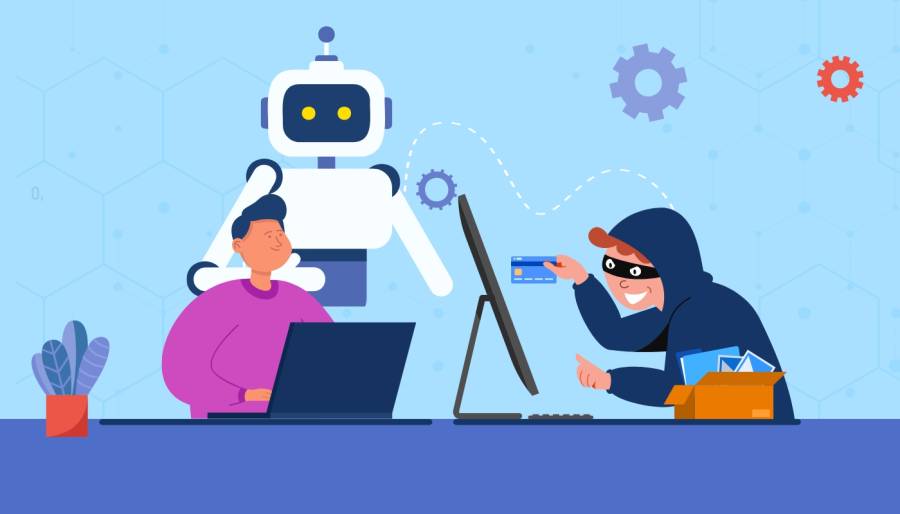The pandemic led to a widespread acceptance of remote work, which initiated digital transformation efforts and fast-tracked the adoption of new software and technology for many businesses—including the financial industry. The prevalence of smartphone usage has made online banking an absolute must-have to keep up with the competition. This reliance on technology for many of the essential functions of banking has put major stress on cybersecurity systems and led to an increase in data security risks.
Consumers and regulators have stressed the importance of maintaining proper cybersecurity measures throughout the expansion of banking services.
Digital Transformation’s Effect on Data Security Risks
Digital transformation refers to the adoption of new technologies and software that significantly impacts the way a business operates. Cloud computing, AI, mobile functionalities, and more are generally included in this effort.
While digital transformation can greatly increase a company’s value to its customers, it can also introduce some potentially damaging data security risks. Companies typically increase the amount of data they handle, which can strain their existing data security strategy.
Regulatory compliance, managing new data sets and addressing emerging cybersecurity concerns all become more difficult when companies undergo a digital transformation.
Speed Should Not Come at the Expense of Data Security
Financial companies handle their customers’ most sensitive information. The exposure of financial data and personally identifiable information (PII) can devastate an individual.
Utilizing new software and expanding offerings are all aimed at improving the user experience. Mobile check deposits, online transfers, fraud detection—these services make our lives much easier. However, the pursuit of digital transformation can be corrupted if an organization is too focused on the end result without considering what it takes to get there.
Hurrying through the development of new updates and applications leads to situations that benefit cybercriminals and not the end user. Buggy or otherwise faulty programs cause corrupted or exposed data and have the potential to create back doors to bad actors.
Digital transformation can provide great value to banking customers. However, failing to keep data security in mind compromises this process, leading to exposed data and falling out of compliance with data protection regulations.
Taking the time to properly plan these improvements and paying attention to critical considerations result in stricter safeguards to sensitive data for a company, as well as its customers.
Here are 10 ways financial institutions can support data security while pursuing a digital transformation:
1. Emphasize Quality
A high-quality application or update can mean several different things. Let’s separate them into “front-end quality” and “back-end quality.”
Front-end quality refers to the benefits the end user gains from using the product. An example of this for online banking is the ability to scan a check with your phone and deposit it into your account.
Back-end quality refers to the supporting IT infrastructure, including the health of the code that makes up the product.
And while both considerations boil down to code quality, DevOps teams are often tempted by the need to be quick. This leads to what’s known as “technical debt.” These refer to deficiencies in the product that are understood and need fixing down the road after the product is released.
Prioritizing front-end quality over back-end quality leads to errors in live environments that have the potential to create back doors for cybercriminals and puts your system data in unnecessary danger.
2. Maintain Proper Permissions
One of the reasons a digital transformation makes it more difficult to protect against data security risks is that larger data sets are more difficult to secure. In short, more data creates more opportunities for failure. This same concept extends to the number of team members with permissions to view sensitive data.
Team members should only have access to the data sets they need to perform their job functions. Anything beyond that leads to vulnerabilities that increase the likelihood of costly exposures, leaks, and corruption.
Human error is unavoidable. Fortunately, automated scanners can be leveraged to verify proper profile and permissions settings. Automating this process greatly increases the stability of your environment.
While this isn’t to imply that a team member would maliciously attack your system, it is possible. Typically, however, it is simply an honest mistake that leads to the exposure of sensitive data. And for financial institutions, this has a dramatic impact on customers as well as potential non-compliance with applicable data security regulations.
3. Backup Everything
Rapid expansion can have unforeseen consequences. And when an organization is implementing new software and IT processes, it’s best to cover your bases. This is true for every industry, but it’s essential for regulated industries like finance.
Organizations need to maintain a recent backup and reliable recovery system to achieve a company’s Recovery Point Objectives (RPOs) and Recovery Time Objectives (RTOs). Failure to perform backups leads to costly outages and falling out of compliance with regulations.
Even the best data security strategies are susceptible to outages. Some factors are simply out of our control—like natural disasters and power failures, for example.
Regulations differ between geographic areas, but they all have specific stipulations about how long information can be kept on file and how it must be protected. These factors extend to data kept in backup repositories, so it’s important to source a tool that offers these functionalities.
4. Utilize Encryption and Data Masking
When handling volumes of data, encryption and data masking are essential tools for financial companies to protect sensitive information throughout a digital transformation and beyond.
The amount of personal data stored on a bank’s IT network is overwhelming. As these data sets grow during a digital transformation, they must be protected just as vigorously. Building out secure entry points and firewalls goes a long way toward supporting this, but it doesn’t address the data itself.
Data masking and encryption are ways to hide sensitive data in plain sight. These tools randomize data sets, essentially turning it into code that can’t be understood even if a cybercriminal gains access to it.
Financial companies should use these practices in live environments as well as in backup repositories to properly protect critical data and reduce data security risks.
5. Prioritize Small, Frequent Updates
The expectations of banking customers are always evolving. Organizations are constantly rolling out new services and features. Banks need to be flexible in their releases while also focusing on data security.
When it comes to introducing new services to the market, it is tempting to swing for the fence. But massive releases take a long time to complete and even longer to ensure they are secure. This is why smaller updates, released more frequently, are often preferable.
Building out a mobile-first design for a banking website is a huge lift. And while this needs to be addressed during your digital transformation, it isn’t the only priority your development team is working on.
Smaller updates that tweak existing designs, patch misfires, and address emerging data security vulnerabilities are essential for the proper upkeep of an IT system. Not all problems are customer-facing, but every solution will inevitably serve your customer.
6. Implement Multi-Factor Authentication
A secure platform is an essential component of a complete data security strategy. The first line of defense against bad actors is the login screen. As mentioned earlier, companies are navigating the expansion to remote working capabilities. An unavoidable aspect of this is an increase in attack surfaces.
Using multi-factor authentication (MFA) creates an additional layer of insulation between public access and the inner workings of your banking system.
Unfortunately, passwords are easy to crack unless the user adheres to strict best practices. Usually, when a password fails, the cybercriminal has immediate access to large sections of the company’s network.
Implementing multi-factor authentication adds a second security layer that requires the account owner to verify they are the person accessing the account. According to Microsoft, multi-factor authentication makes an account 99.9% less likely to be compromised. This is a critical data security step for businesses in regulated industries like finance.
7. Host Servers On-Premises When Possible
With an increased reliance on IT systems, financial institutions need to maintain as much control over their networks as possible. And while cloud computing is incredibly popular for global organizations, working with on-premises servers whenever possible gives banks the impenetrable security they need.
Utilizing servers physically stored in an organization’s own data center affords complete control over who accesses the system. This helps financial companies comply with applicable data security regulations and provide their customers with the protections they deserve.
Security measures are more customizable with direct access to your servers. This includes capabilities like network segmentation. Separating critical parts of the network ensures that even if one section of the system becomes corrupted, it won’t infect other areas of the platform.
On-premises systems require more upkeep and are more expensive to maintain, so it doesn’t work in every situation. But those who make the investment have the highest levels of security.
8. Analyze Access Logs and Export Reports
You can’t guard against data security risks if you don’t know they exist. And sometimes, breaches can occur in a system for months without the organization knowing about it. Frequent scans of your system must be a continuous part of your data security strategy during and after a digital transformation.
Use access logs and export reports to find and identify unauthorized use of your network. Analyzing access logs will show any outliers, which can point to an outsider accessing your system. For instance, if you notice a login attempt from Texas when you don’t have any employees there, it’s a sign that something unexpected is happening.
Likewise, numerous, unapproved export reports of system data are a sure sign someone has infiltrated your network and is accessing protected information.
Vigilant oversight of who is accessing your platform and what they are doing will give you the opportunity to shut down cyberattacks before they impact multiple areas of your environment.
9. Be Vigilant Against Phishing Attempts
Phishing refers to emails that purport to be from a sender the recipient trusts. The goal is to trick the user into providing login credentials, financial information, or personal information. Falling victim to these types of attacks is personally damaging, but if it happens on a company device, it has ramifications for the entire system.
Requiring employees to undergo continued, updated training helps workers stay vigilant against these types of attacks, learn how to avoid falling victim to them, and teach users what to do when they spot a phishing attempt.
For example, Target suffered a data breach when a connected third-party vendor fell victim to a phishing attack. This resulted in the compromise of 40 million credit and debit cards and 70 million customer records. This simple mistake had a huge impact.
The expansion of a financial company’s IT infrastructure presents an opportunity for cybercriminals to gain access through a phishing attack and cause widespread damage.
10. Encourage Open Communication
Team members are our greatest asset when securing our technological platforms. Helping each other maintain data security best practices, flagging vulnerabilities, and conducting oversight of critical features all help financial companies remain secure and compliant.
Part of your data security training strategy concerns the chain of command. Employees need to be sure who is responsible for addressing data security considerations.
Taking a DevSecOps approach to application development instills data security considerations into every step of the process. This is the recommended strategy for producing secure applications and updates to support a digital transformation.
Staying Secure Throughout a Digital Transformation
Data security risks are a massive component of a financial institution’s digital transformation. Producing new applications and updates shouldn’t be separate from maintaining proper levels of security. In fact, the products produced by a financial company’s development pipeline should aim to further protect the system.
Organizations that incorporate these strategies will create a digital transformation that enhances their security and compliance as they build out new capabilities and services.








